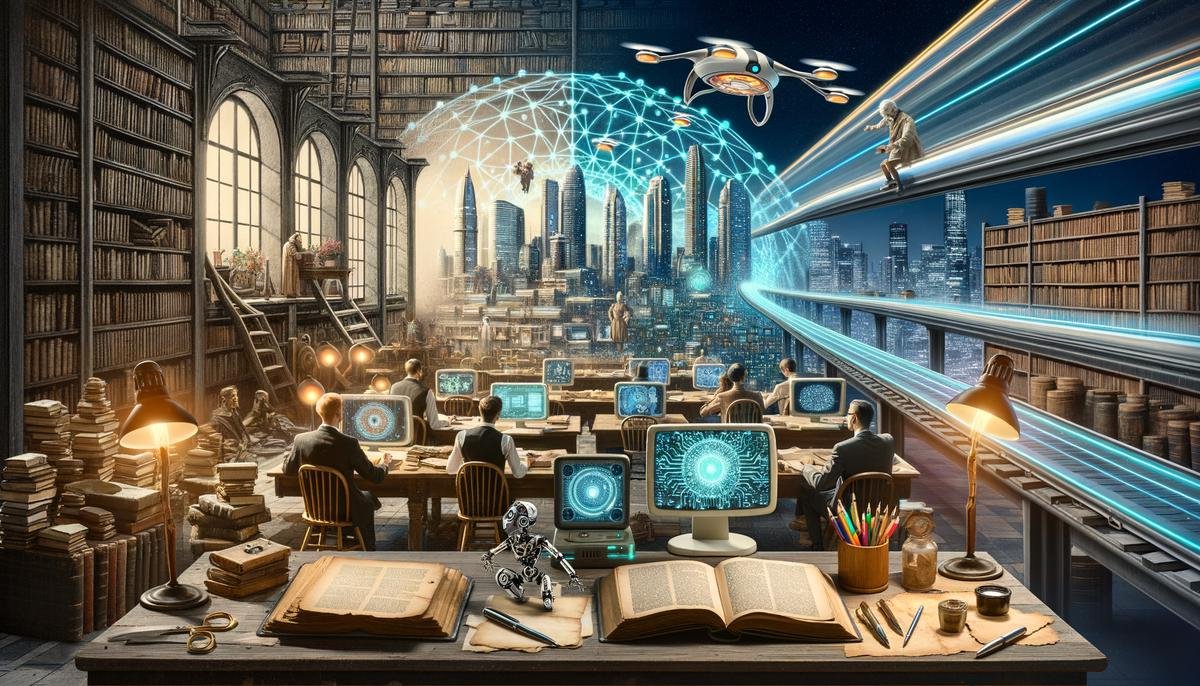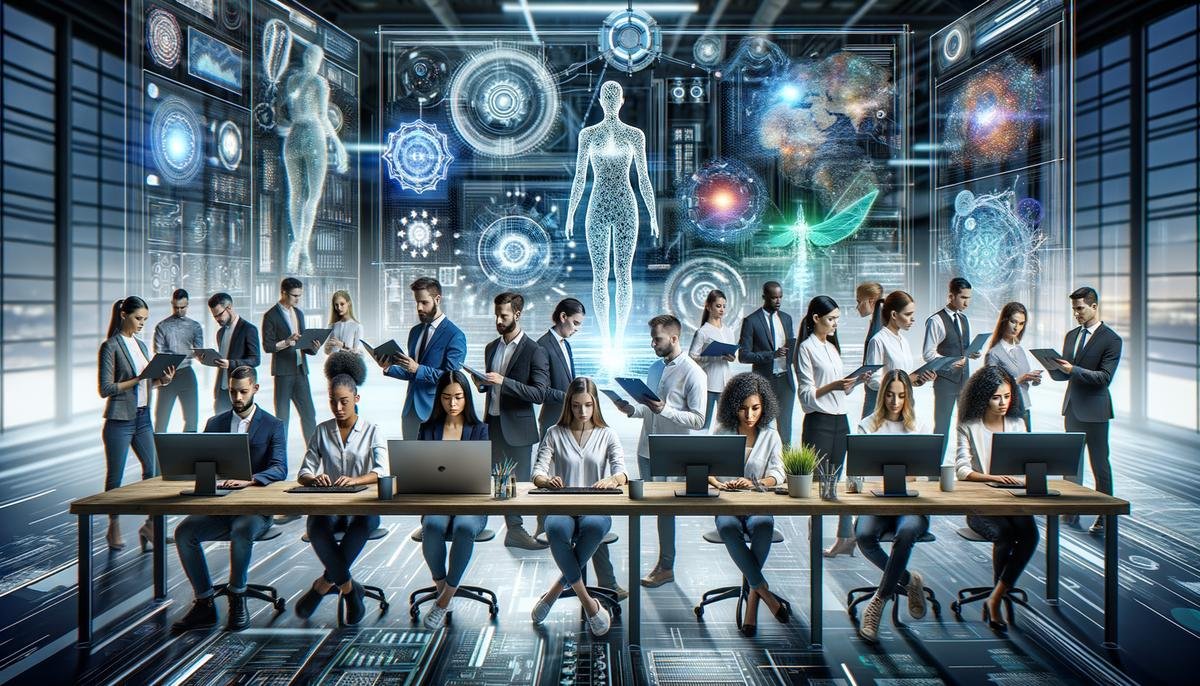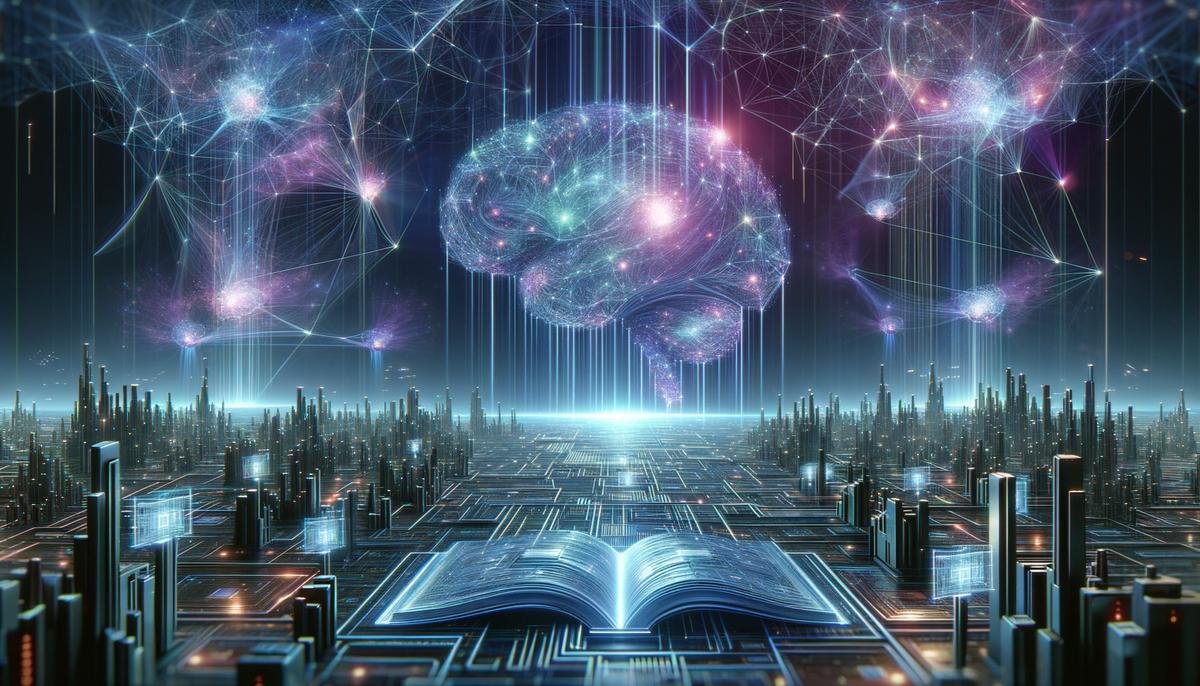Artificial Intelligence, or AI, is quickly reshaping the world of technology, impacting many aspects of daily life and the broader societal landscape. By exploring the realms of AI’s development, advancements, ethical considerations, and future prospects, we aim to shed light on how this technology is not just transforming industries but also challenging our perspectives on privacy, creativity, and collaboration. As we examine the multifaceted nature of AI, it’s essential to understand both its potential and limits, guiding us toward responsible and innovative uses.
Understanding Artificial Intelligence
AI, or Artificial Intelligence, is a game-changer in the world of technology. It’s like giving a computer or a robot a brain that can think, learn, and make decisions much like a human does. At the heart of AI is the ability to mimic human intelligence.
Let’s break it down. AI systems are powered by algorithms – sets of rules or instructions – that enable them to process vast amounts of information quickly. These algorithms are designed to spot patterns, learn from data, and make predictions. There are two main types of AI: narrow AI, which is programmed to perform specific tasks, and general AI, which has the understanding and intelligence of a human being. Right now, what we see most often is narrow AI.
One key component of AI is machine learning. This is where computers learn from data without being explicitly programmed for every step. Imagine teaching a computer to recognize a cat. Instead of telling it every detail about what makes a cat, you show it thousands of cat pictures so it learns to identify them on its own. This is machine learning in action.
Deep learning, a subset of machine learning, takes this a step further. It involves neural networks, which are designed to imitate how a human brain operates. These networks can learn and make decisions independently. The more data these networks are fed, the smarter they become, enabling them to tackle more complex tasks.
AI is not just about programming computers to learn; it’s about enabling them to understand and interact with the world. Natural Language Processing, or NLP, allows AI to understand and generate human language. This is how virtual assistants like Siri or Alexa can understand your questions and respond in a way that feels natural.
Behind the magical experiences AI provides, from voice recognition to predictive text, and recommendation systems on your favorite streaming services, are complex processes. Data is the lifeblood of AI. It relies on collecting, analyzing, and learning from data to improve over time. This is why AI seems smarter the more you use it; it’s learning from the vast amount of data it collects through interaction.
AI’s workings might sound complex, but its goal is simple: to make machines smarter to help us solve problems faster and more efficiently. Whether it’s helping doctors diagnose diseases earlier, enabling cars to drive themselves, or simply recommending the next song on your playlist, AI is transforming the way we live and work. It’s a journey from data to learning, to making decisions – a journey that’s reshaping the future.

Current Capabilities of AI
Building on the foundational concepts of artificial intelligence (AI), it’s essential to delve into the specific capabilities and advancements AI has achieved in recent years. AI today is not just a futuristic vision; it’s a present-day reality, influencing everything from healthcare to entertainment, and even our daily routines.
In the realm of healthcare, AI’s application is groundbreaking. It powers systems that can analyze complex medical data, assist in early disease detection, and personalize treatment plans for patients. For instance, AI algorithms can sift through millions of mammograms at a pace no human can match, spotting potential cancers with a precision that oftentimes surpasses that of experienced radiologists. This not only accelerates the diagnostic process but also increases its accuracy, potentially saving lives through early intervention.
The financial sector benefits from AI’s ability to detect fraudulent activities and manage risk. Banks and financial institutions employ AI systems to monitor transactions in real time, identifying patterns that may indicate fraud. Moreover, AI-driven chatbots have become the first line of support, capable of handling a multitude of customer inquiries without human intervention, thus improving the efficiency of customer service.
AI’s influence stretches into the automotive industry, notably through the development of autonomous vehicles. These vehicles rely on AI to process data from various sensors and cameras to navigate safely. The promise of self-driving cars could revolutionize transportation, reducing accidents caused by human error and optimizing traffic flow.
In the entertainment industry, AI is used to personalize content recommendations on platforms like Netflix and Spotify, enhancing user experience by aligning suggestions with individual preferences. The underlying AI algorithms analyze users’ viewing or listening habits to predict and recommend content likely to be enjoyed, keeping users engaged and subscribed.
AI is also making strides in the field of robotics, where it equips robots with the ability to learn and adapt to their environment, making them more versatile and capable of performing complex tasks. From assembly lines in manufacturing to exploratory robots in space, AI-enabled robotics represents a leap forward in efficiency and the ability to undertake missions beyond human capabilities.
The advancement of AI in language processing has led to the development of sophisticated voice-activated assistants, such as Siri and Alexa, which have become commonplace in many homes. These assistants can understand and process natural human language to follow commands, search the internet, manage schedules, and even control smart home devices, showcasing the versatility and integration of AI into daily life.
Despite the significant progress, it’s critical to acknowledge that AI still faces challenges, particularly in understanding human emotions and the subtleties of human language comprehensively. However, ongoing research and development are aimed at overcoming these hurdles, pushing AI towards even greater capabilities.
As we look to the future, the potential of AI to transform our world is immense. From enhancing productivity across industries to tackling complex global challenges like climate change, AI holds the promise of driving significant advancements. It’s a tool that, when harnessed responsibly, has the power to enhance human capabilities and improve the quality of life on a global scale.

The Ethical Implications of AI
As the influence of Artificial Intelligence (AI) grows across various sectors, it’s becoming increasingly evident that its rapid development is presenting critical ethical challenges. These challenges span a wide array of concerns, from privacy issues and bias in AI algorithms to the broader societal impacts such as job displacement and security concerns.
One of the primary ethical dilemmas revolves around privacy. AI systems, particularly those that rely on large datasets to improve their algorithms, can access and analyze vast amounts of personal information. This raises questions about how this data is collected, used, and stored. The potential for invasive surveillance by governments or corporations through AI technologies puts individual privacy at risk, prompting a need for strict data protection regulations.
Bias in AI is another significant ethical concern. AI systems learn from data, and if that data contains biases, the AI will too, leading to potentially discriminatory outcomes. For example, facial recognition technologies have shown biases against people of color and women, leading to higher misidentification rates. This poses serious implications for law enforcement and hiring practices, among other areas, where such biases could result in unfair treatment.
Moreover, the rapid automation facilitated by AI could lead to massive job displacement. While AI optimizes efficiency and reduces costs in manufacturing, customer service, and even creative professions, it also means fewer jobs for human workers. The ethical challenge here lies in balancing technological advancement with the societal impact, particularly on employment and economic inequality.
There’s also the ethical issue of accountability. When AI systems make decisions, especially those impacting human lives like in healthcare or autonomous vehicles, determining who is responsible for those decisions becomes complex. This ambiguity in accountability raises concerns about legal and moral responsibilities, especially in cases where AI-induced decisions lead to harm or damage.
Security concerns are paramount as well. As AI systems become more integrated into critical infrastructure and military applications, the risk of these systems being hacked or used for nefarious purposes increases. The potential for AI-powered weapons or surveillance systems to be misused poses significant ethical dilemmas regarding the militarization of AI and the need for international regulations.
While AI holds the promise of driving innovation and solving complex problems, these ethical challenges highlight the need for a careful approach to its development and deployment. It is essential that policymakers, technologists, and the public work together to establish ethical guidelines and regulations that ensure the benefits of AI are realized while minimizing its potential harms. This includes creating transparent systems that allow for accountability, ensuring fairness in AI algorithms, and implementing strategies to mitigate job displacement as AI continues to evolve. Facing these ethical challenges head-on is crucial in steering the future of AI towards positive impacts on society.

The Limitations of Artificial Intelligence
While the advancements and capabilities of Artificial Intelligence (AI) are truly remarkable, there are several arenas where AI still falls short. This exploration aims to delve into those shortcomings, providing not only a clear picture of current limitations but also shedding light on areas for future improvements.
One significant shortfall of AI is its inability to mimic the depth of human creativity. AI can generate new content based on existing data, but the spark of originality and the emotional depth seen in human creativity often elude it. For example, in the arts, AI-generated paintings or music can mimic styles and patterns but usually lack the emotional resonance and nuance that human artists can convey.
AI’s understanding and interpretation of context is another area needing enhancement. Although AI can process and analyze large data sets, it struggles with ambiguous situations or contexts where nuanced understanding is required. This limitation becomes apparent in language translation services or sentiment analysis, where the subtleties and nuances of human languages often get lost or misinterpreted by AI systems.
The decision-making process in AI also faces limitations, primarily because it is driven by data and algorithms. This reliance on historical data means AI can struggle with novel situations not covered in its training data. Moreover, without the ability to think abstractly or apply ethical considerations as humans do, AI decisions can sometimes seem inappropriately calculated or lack empathy, posing challenges in fields requiring nuanced judgment like law or counseling.
Another critical area where AI falls short is in emotional intelligence. Despite advances in Natural Language Processing (NLP) and machine learning, AI systems cannot fully understand or replicate human emotions. This limitation is a significant barrier in creating AI that can genuinely interact with humans in a deeply empathetic or emotionally responsive manner, such as in caregiving roles or mental health support.
Additionally, AI’s reliance on data brings forth the challenge of data quality and availability. AI systems are only as good as the data they are trained on. In many cases, data can be biased, incomplete, or not diverse enough, leading to AI systems that perpetrate existing biases or are ineffective in diverse scenarios. This poses a significant challenge in creating AI systems that are fair, unbiased, and universally effective.
In conclusion, while AI continues to make strides in various fields, its limitations in creativity, context understanding, nuanced decision-making, emotional intelligence, and dependency on quality data underscore the need for ongoing research and development. Addressing these shortcomings will not only enhance AI’s capabilities but also expand its applicability, ensuring it can meet the complex and varied needs of humans in a more holistic and effective manner.

The Future of AI Development
With each stride in Artificial Intelligence (AI), we gaze into a future brimming with untold possibilities. As we vault over current technological hurdles, AI is set to redefine innovation, tethering closely to every facet of human life. The question that percolates through the minds of researchers, entrepreneurs, and the lay public alike is, “What’s next for AI?”
In the near horizon, expect AI to amplify its influence in personalizing education. Tailored learning experiences, powered by AI, will cater to the individual needs, abilities, and learning pace of students. This bespoke approach promises not just improved academic performance but also ignites a deeper passion for learning across diverse subjects.
Simultaneously, AI is gearing up to make more autonomous strides in healthcare. Beyond diagnostics and treatment, AI will soon navigate patient care autonomously, offering real-time monitoring and predictive insights that preempt health crises. This leap could herald a new era where healthcare is proactive, not just reactive.
On the frontiers of creativity, AI is poised to break the mold. While it’s true that AI’s current grasp on emotion and context is somewhat mechanical, advancements are underway to equip AI with a more nuanced appreciation of creativity and art. This evolution will see AI not just mimicking human creativity but also potentially pioneering novel art forms and creative expressions.
The integration of AI with the Internet of Things (IoT) is set to redefine smart living. Smart homes that adapt to your preferences, cities that manage traffic flow autonomously, and workplaces that optimize energy use are just the tip of the iceberg. This seamless merger will elevate the concept of smart living, making it more intuitive and efficient.
Regarding sustainability, AI offers a beacon of hope. With climate change accelerating, AI’s role in monitoring environmental changes and optimizing resource use is invaluable. AI-driven models can forecast environmental changes with startling accuracy, offering humanity a crucial tool in mitigating the impacts of climate change.
Ethics and governance in AI will also take center stage. As AI systems become more embedded in daily life, ensuring these systems operate fairly and transparently is paramount. The future will likely see a global framework for AI governance, balancing innovation with ethical considerations to ensure AI benefits all of humanity.
Lastly, AI is on the brink of enhancing human-AI collaboration. Rather than seeing AI as a tool or a threat, the future posits a symbiotic relationship where humans and AI co-create, learn, and solve complex challenges together. This partnership will unlock human potential and open up new realms of possibility.
The trajectory of AI is as thrilling as it is unpredictable. Yet, one thing is clear – AI is not just about machines taking over mundane tasks. It’s about augmenting human capabilities, fostering creativity, and spearheading a future where technology and humanity are inextricably linked. On this frontier, the possibilities are limitless, and the journey has just begun.

As we explore the expansive terrain of Artificial Intelligence, it’s evident that AI holds the potential to be a transformative force across diverse sectors. However, its success hinges on addressing ethical challenges, embracing collaboration, and ensuring inclusivity in its benefits. By fostering a balanced approach to AI development that equally values technological advancements and ethical considerations, we can unlock avenues for meaningful innovations that enhance human capabilities and lead to a more equitable and interconnected world. The essence of AI’s promise lies in its ability to augment our lives, reminding us that the heart of technology is its service to humanity.



